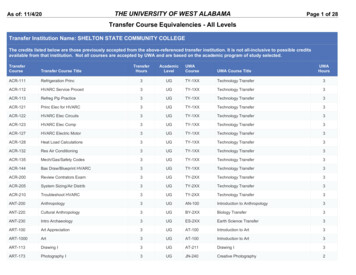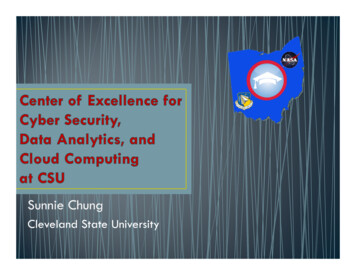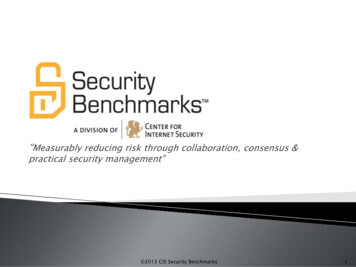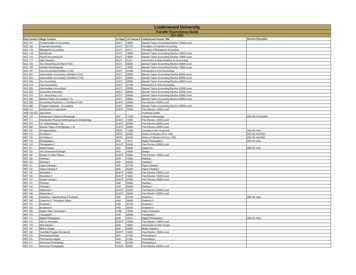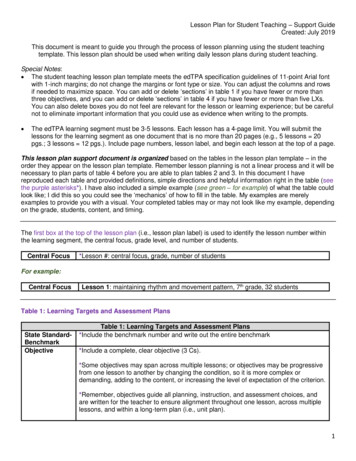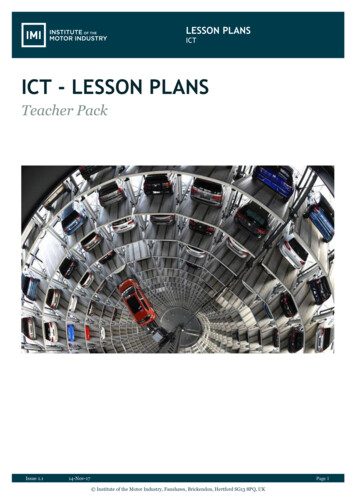
Transcription
CIS Self-Study Lesson PlanLesson No. CIS 254 (Instrument Continuing Education - ICE)Sponsored by:by Mattie Castro, CRCST, CIS, CHL, CHMMC andNatalie Lind, CRCST, CHL, FCSPOWERED SURGICALINSTRUMENTSLEARNING OBJECTIVES1. List common types of powered surgicalinstruments2. Review powered surgical instrumentaccessories3. Identify cleaning principles for poweredsurgical instruments4. Review preparation and sterilizationprinciples for powered surgicalinstrumentsInstrument Continuing Education (ICE) lessonsprovide members with ongoing education inthe complex and ever-changing area of surgicalinstrument care and handling. These lessons aredesigned for CIS technicians, but can be of valueto any CRCST technician who works with surgicalinstrumentation.Earn Continuing Education Credits:Online: Visit www.iahcsmm.org for onlinegrading at a nominal fee.By mail: For written grading of individual lessons,send completed 15-question quiz and 15to: PEC Business Office, Purdue University, Stewart Center Room 110, 128 Memorial Mall, WestLafayette, IN 47907-2034.Scoring: Each 15 question quiz graded online atwww.iahcsmm.org or through Purdue University,with a passing score of 70% or higher, is worthtwo points (2 contact hours) toward your CISre-certification (6 points) or CRCST re-certification(12 points).More information: IAHCSMM provides onlinegrading service for any of the Lesson Planvarieties. Purdue University provides gradingservices solely for CRCST and CIS lessons. Directany questions about online grading to IAHCSMMat 312.440.0078. Questions about writtengrading are answered by Purdue University at800.830.0269.POWERED SURGICAL INSTRUMENTS (PSI) PLAY A UNIQUE ROLE INthe operating suite. They reduce the time of surgical procedures and providefunctionality and consistent performance in surgical procedures. PSIs arecomplex surgical devices and the processes used to clean, inspect and sterilizethem are also complex. This lesson will focus on general principles of PSI care andhandling. Note: Always follow the manufacturer’s instructions for use (IFU) for thespecific PSI being processed.OBJECTIVE 1: LIST COMMONTYPES OF POWERED SURGICALINSTRUMENTSThe term “powered surgical instruments”describes instruments that are poweredby an external power source. PSIs arepowered by one of three basic sources:Battery PowerBattery-powered instruments are poweredby rechargeable batteries. Because theywork with a battery that is inserted intotheir handpiece, they do not have acable or cord attached. Battery-poweredinstruments require a charger, andbatteries must be charged before beingdispensed. It is important to rememberthat not all batteries are compatible withall battery-powered instruments.an air source to operate. Air (nitrogen) isdelivered through an air cord attached toa free-standing tank or an air access portin a column, ceiling or wall.PSIs are also grouped by their shapeand the way they are held. The mostcommon shapes are pencil grip and pistolgrip. The following photo provides anexample of each type.In addition to their power source,shape and grip, PSIs are differentiatedby the mechanical action they provide.Some PSIs are designed to saw, othersare designed to drill and others provideadditional specialized actions. Specificaccessories and actions will be addressedin Objective 2.Instruments powered by electricity mustbe connected to an electrical powersource. They come equipped with a powercord or power unit.OBJECTIVE 2: REVIEW POWEREDSURGICAL INSTRUMENTACCESSORIESEvery PSI has a power source and ahandpiece; however, many handpiecesrequire specific accessories in order tofunction. Common attachments include:Air Power (Pneumatic)Saw BladesAir powered instruments run usingcompressed air or nitrogen. They requireThere are several PSIs designed to sawbone. Types of saw styles and attachmentsElectrical
CIS Self-Study Lesson PlanFigure 1: Battery-powered surgical instrumentFigure 2: Batteries on chargerFigure 3: Electrical-powered surgical instrument with cordFigure 4:Pneumatic-poweredsurgicalinstrumentwith hoseFigure 6: Piston grip-powered surgical instrumentFigure 5:Pencilgrip-poweredsurgicalinstrumentFigure 7: Powered surgical instrument with attachments
CIS SELF-STUDY LESSON PLANWhen performing manual cleaning, be sure to manipulatemovable parts and brush cannulas and areas that cannot beaccessed with a cleaning cloth. Be sure to perform manualcleaning as specified in the device’s IFU.include oscillating saws that use a sideto-side motion to cut; sagittal saws thatuse a back-and-forth motion to cut;and reciprocating saws that use a pushand-pull motion to cut. Some saws aredesigned for special functions, such assternal saws that are used to open thesternum for open heart surgery. Mostof the blades that accompany thesesaw attachments are disposable. Sawblades are designed to cut bone andcan dull quickly. Blades should neverbe reprocessed and reused unless themanufacturer has provided specificinstructions to do so.Many handpieces are dispensed withseveral attachments that enable them tobe used in multiple applications. Note:The cleaning requirements for each piecemay be different, so it is imperative todiligently follow the manufacturer’s IFU.OBJECTIVE 3: IDENTIFY CLEANINGPRINCIPLES FOR POWEREDSURGICAL INSTRUMENTSCleaning of PSIs is a complex process.Their configuration is sometimes difficultto clean and handpiece cleaning relieson manual processes. While each PSI isdifferent, basic cleaning processes shouldinclude:Rotary AttachmentsPSIs designed for use with rotaryattachments include drills, burrs andreamers. These accessories come invarious styles and sizes, and some drillsare designed for specific applications,such as micro drills designed to drivevery small wires through bone duringear surgery. Many drill bits and burrsare disposable and should not be reused.Reamers, such as spherical, femoral oraxial reamers used for hip surgery, arereusable.Other Specialized Devices andAttachmentsSome other common PSIs andattachments include: dental drills usedin the repair and reconstruction of jawbones and teeth; cebatomes that are usedto remove cement; and dermatomes thatremove skin.Point-of-Use CleaningDisposable components, such as drillbits, burrs and saw blades, should beremoved and discarded at point ofuse. Components should be wiped toremove gross soil. It is important tokeep components moist so blood doesnot dry on the instrument; however,handpieces and some accessories cannotbe immersed. For those items, an externalspray designed for use with the specificinstrument may be used. Another optionis wrapping the components in a moisttowel. PSIs should be transported to thedecontamination area and cleaned assoon as possible after use.Initial DecontaminationOnce the components are received inthe decontamination area they shouldbe sorted to separate components thatmust be hand cleaned from ones that maybe cleaned using a mechanical cleaningprocess.The biggest challenge when cleaningPSIs is conducting a thorough cleaningprocess while preventing fluid invasion.Fluid invasion occurs when fluid(cleaning solution, rinse water, etc.) entersthe handpiece of a PSI. That fluid mayimpede the function of the device andshorten its life. Fluid can also contaminatethe interior of the device. Suchcontamination makes it impossible tosterilize the device, and in some models,may create a risk of the fluid insideleaking out onto the sterile field duringuse. Internal moisture may also corrodebatteries, motors and switches.Fluid invasion is dangerous – posingpatient safety risks – and costly becauseof the associated instrument repairand replacement. It is essential to holdthe handpiece in a position that willprevent fluid from entering. Manydecontamination areas use a cleaning airhose or battery connected to (or insertedin) the device to prevent fluid invasion.Cleaning hoses and batteries can be madeby designating a used hose or batteryto remain in the decontamination areafor cleaning. Many facilities mark thoseaccessories with instrument tape to helpensure that they do not get mixed in withusable hoses and batteries.When performing manual cleaning,be sure to manipulate movable parts andbrush cannulas and areas that cannot beaccessed with a cleaning cloth. Be sure to
CIS Self-Study Lesson Planperform manual cleaning as specified inthe device’s IFU. Remember, not all soil isvisible, so meticulous cleaning of all areasis critical.It is also important to rinse allcomponents thoroughly as residue fromcleaning chemicals may impede thesterilization process and harm patients.Instruments should be dried as directedby the manufacturer’s IFU.OBJECTIVE 4: REVIEWPREPARATION AND STERILIZATIONPRINCIPLES FOR POWEREDSURGICAL INSTRUMENTSWhen PSIs arrive in the assembly areathey must be inspected to help ensurethey are functional and ready for use.All attachments should be inspected forcleanliness and manipulated to ensurethat moving parts move freely.Unlike most other instruments, PSIinspection usually includes handpiecetesting; this requires that the assemblyarea have access to each type of powersource, compressed air, electricity andbatteries. A charged battery can be usedto test battery-powered devices. Oncethe device is connected, it should be runon all available settings to ensure it is inworking condition prior to sterilization.Some devices may require lubrication.Check the specific manufacturer’s IFU forlubrication requirements.Air-powered handpieces must be testedusing the correct pounds per squareinch. Excessive air pressure can damagethe device and exert excessive pressureon the air hose. Like battery-poweredinstruments, air-powered instrumentsshould be tested on all available settings.Hoses for PSI should be coiled looselywhen they are prepared for sterilization.After inspection, all componentsshould be disassembled to facilitatethe sterilization process. Some devicescome with a container specially designedfor the device and its components.Others may need to be placed in genericmesh instrument trays. Regardless ofthe containment method used, whenpackaging PSIs it is important toprotect delicate components and returnhandpieces to the neutral (off) position.Do not overcrowd trays and place itemsin a manner that will allow the sterilant tocontact all surfaces.Sterilization cycles may vary. Be sureto sterilize using the cycle specified bythe manufacturer. Upon completion ofthe sterilization cycle, adequate time isneeded for the instrument tray to coolbefore handling the PSI tray.CONCLUSIONPowered surgical instruments arenecessary for many surgical procedures.They reduce the length of surgery andprovide consistent performance, andthey represent a significant investmentto any healthcare facility. Both Surgeryand Central Service departments shouldbe inserviced in the proper care andhandling of these complex devices.Proper care and handling of poweredsurgical instruments will keep patientssafe and extend the life of the devices.REFERENCESAssociation of periOperative Registered Nurses.2015. Recommended Practices for Cleaningand Care of Surgical Instruments, Guidelines forPerioperative Practice.Mobile Instrument Service and Repair. 2014.Powered Surgical Instruments. The Challenge ofReprocessing.Rothrock J. 2011. Alexander’s Care of thePatient in Surgery, 14th Edition.Dyonics. 2012. Powered Instruments,Instructions for Use, Smith and Nephew.IAHCSMM acknowledges the assistance of thefollowing two CS professionals who reviewedthis lesson plan:LISA HUBER, BA, CRCST, ACE, FCS; SterileProcessing Manager, Anderson Hospital,Maryville, Ill.PAULA VANDIVER, CRCST, CIS; OrthopedicSpecialist, Anderson Hospital, Maryville, Ill.CIS SELF-STUDYLESSON PLANSTECHNICAL EDITORCARLA MCDERMOTT, RN, CRCSTClinical Nurse IIISouth Florida Baptist HospitalPlant City, Fla.SERIES WRITER/EDITORJACK D. NINEMEIER, PH.D.Michigan State UniversityEast Lansing, Mich.WANT TO BE AN AUTHOR?IAHCSMM is seeking volunteers to writeor contribute information for our CIS SelfStudy Lessons. Doing so is a great way tocontribute to your own professional development, to your Association, and to yourCentral Service department peers.IAHCSMM will provide guidelines andhelp you with the lesson to ensure it will bean enjoyable process. For more information,please contact Julie Williamson(julie@iahcsmm.org).
CIS Self-Study Lesson Plan Figure 1: Battery-powered surgical instrument Figure 2: Batteries on charger Figure 3: Electrical-powered surgical instrument with cord Figure 6: Piston grip-powered surgical instrument Figure 7: Powered surgical instrument with attachments Figure 4: Pneumat-ic-powered surgical instrument with hose Figure 5: Pencil grip-powered surgical

